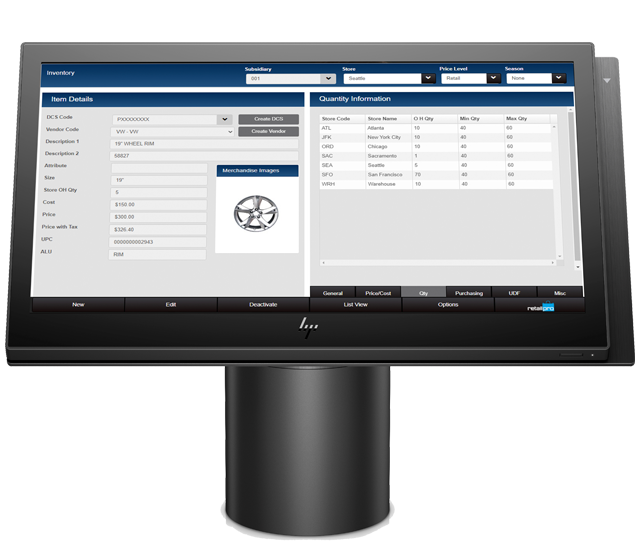Retail Pro Prism: Tracking inventory needs and movement in COVID-19’s accelerated Omnichannel

The uptick in online sales due to COVID-19 has been explosive.
Listrak reports a 40% increase in ecommerce revenue since the United States declared a state of emergency in late Spring.
Research from Klaviyo shows a sudden spike in demand for product categories that help people make the most of time at home, such as the “new essentials” that include electronics, housewares, and office supplies.
Order values of electronics this June 15 was approximately $8 million, for example, compared with roughly $4 million one year ago.
Retailers in the home goods industry are likewise seeing an impressive increase in sales, likely because shelter-in-place laws have made people a bit more conscious of their home environments.
As demand surges, many manufacturers are finding it difficult to keep up. Retailers are faced with figuring out how to efficiently manage inventory during production slowdowns when products are in high demand.
No retailer wants a repeat of the infamous “toilet paper shortage.”
With the uptick in sales, retailers are keeping a closer watch on orders to ensure satisfied shoppers.
Having accurate inventory data is crucial to survival for retail, which is where retail management solutions such as Retail Pro Prism fit in.
Tracking inventory available for omnichannel sales with Retail Pro

Because many physical stores are not yet opened at full capacity, a greater percentage of sales are being funneled through e-commerce platforms.
However, as states and nations reopen commerce, curbside pickup and in-store purchases are being added to the mix even for non-food retail, making it increasingly important that inventory counts across channels are accurate.
But many retailers were only on the path to omnichannel when COVID-19 hit and have had to accelerate digital efforts to create somewhat of a make-shift omnichannel to fill moment’s need.
As the platform for omnichannel data connectivity, Retail Pro Prism also helps retailers fill in the gaps as they transition toward fully integrated data across systems.
Retail Pro Prism gives retailers full visibility into their inventory at each location, whether the goods are at the warehouse, in transit, in the back room, or on the sales floor.
This kind of detailed visibility gives retail managers greater accuracy in tracking inventory, helping minimize unprofitable overstocks and the opportunity cost of shortages.
Automated replenishment capabilities based on minimum and maximum values in Retail Pro also ensure purchase orders are placed in time to prevent shortages.
Integration with retailers’ ecommerce platforms gives a threefold benefit:
- Shoppers are given visibility into which locations near them have the products they want in stock
- Store inventory can be used to fulfill online orders, increasing turn and reducing the need for duplicate inventory sets, one for each channel
- Changes to inventory triggered by online purchases or purchases in store are automatically updated in both platforms, keeping availability accurate
Gauging staffing needs based on transaction and traffic volume

Proper inventory tracking processes not only guarantee items are on hand when requested but can also help with employee staffing.
With less shoppers in stores during COVID-19, certain support staff jobs are not being performed at the same rate, so stocking up on the materials used for those jobs isn’t imperative.
Reduced foot traffic means moving resources and shifting focus. Warehouse workers may need to adjust schedules and workloads to accommodate.
Using reports and visual analytics in Retail Pro, you can compare staffing levels to number of transactions completed per hour, including the number of items per transaction and foot traffic counts.
These kinds of data together will help determine whether an increase in staff would be needed to improve the experience for shoppers as they are coming back to your stores and wanting to find items quickly.
Levi’s: better turn even during COVID-19

Levi Strauss credits smart inventory management with helping it to remain strong during the COVID-19 crisis.
In the first quarter of 2020, the company reported inventories were 7% lower than the prior year’s.
During an investor call, Executive Vice President and Chief Financial Officer Harmit Singh said that Levi’s strategy will continue to focus on inventory management and added that a significant majority of its inventory is core replenishment.
That includes stock it can carry over into future seasons: More than 70% of Levi products are so-called “evergreen products.”
In addition, the retailer plans to increase its ship-from-store capabilities, allowing retail outlets to fulfill e-commerce orders.
When they do venture into a store post Covid-19, customers will want to see well stocked shelves and will not want to wait for shipments to arrive.
With a more proactive approach to tracking inventory and stocking shelves, retailers can keep existing customers happy — and attract new ones.
